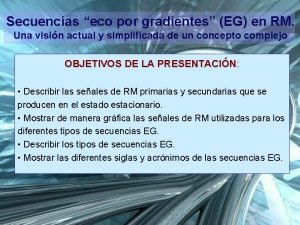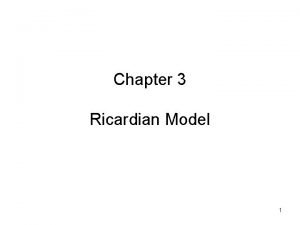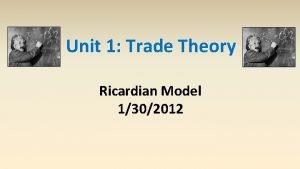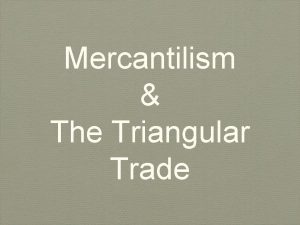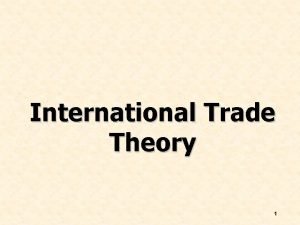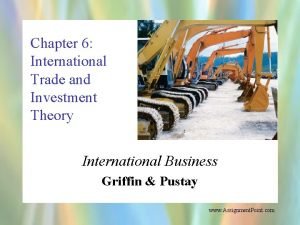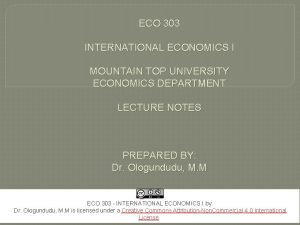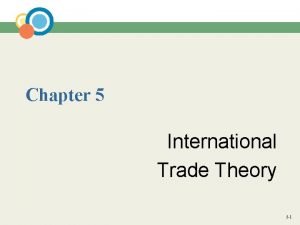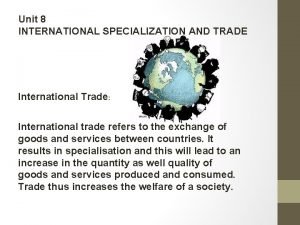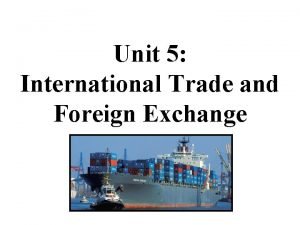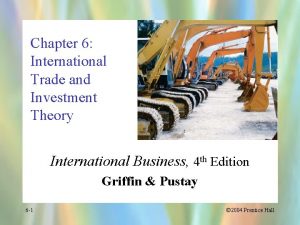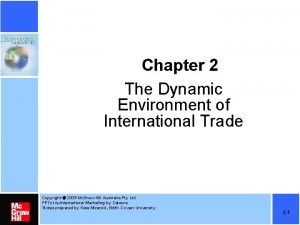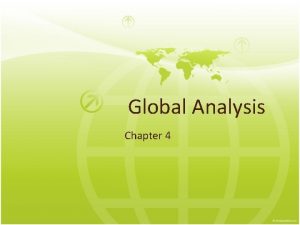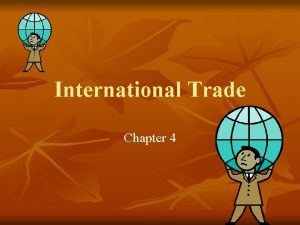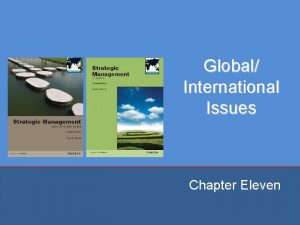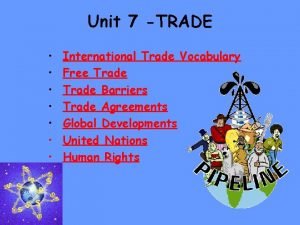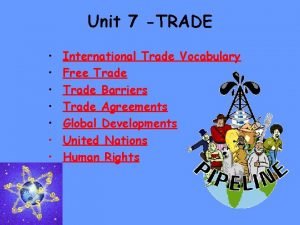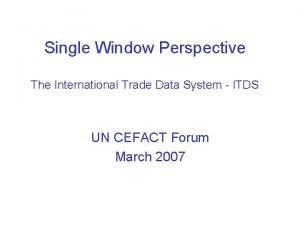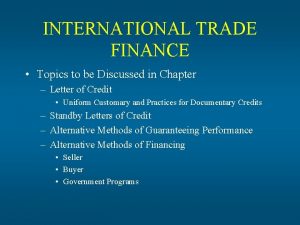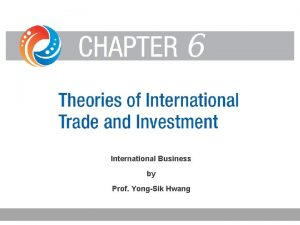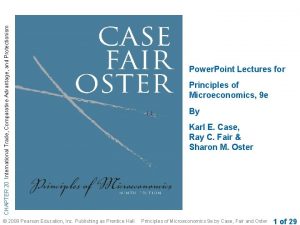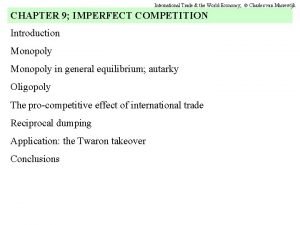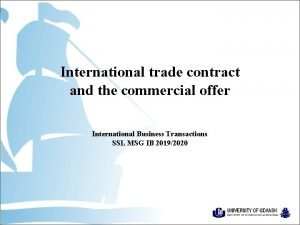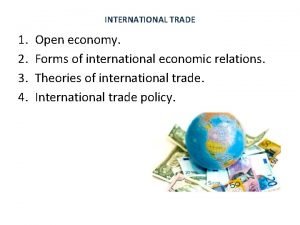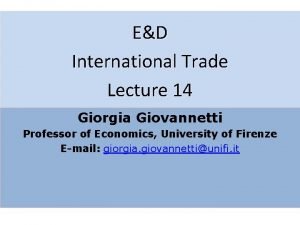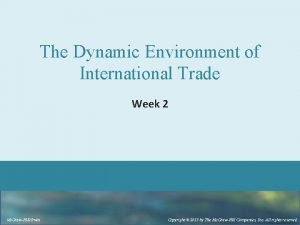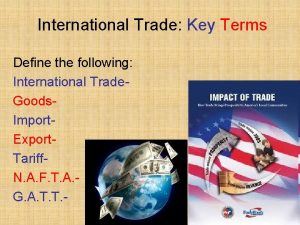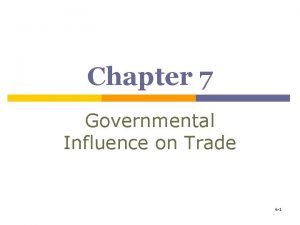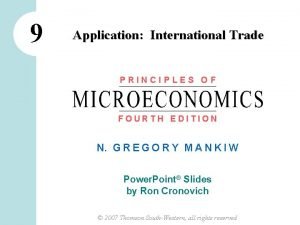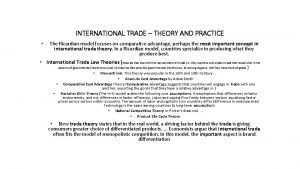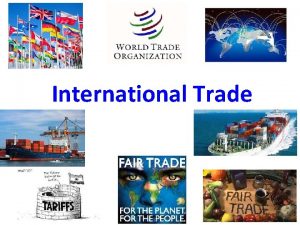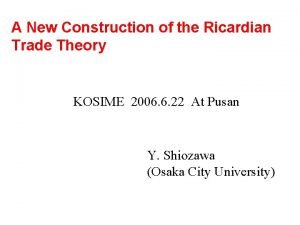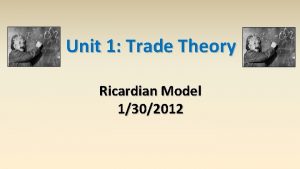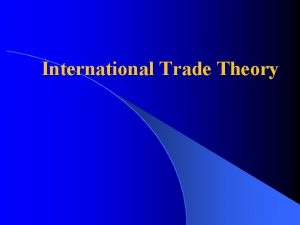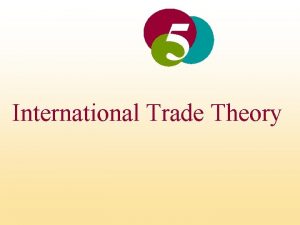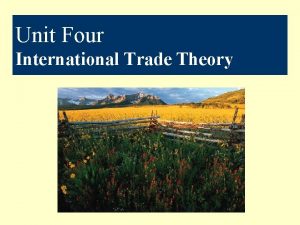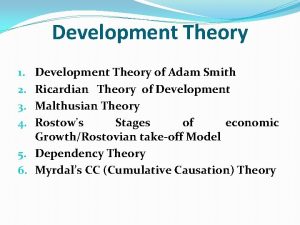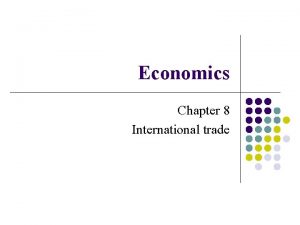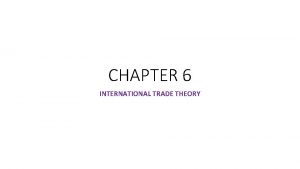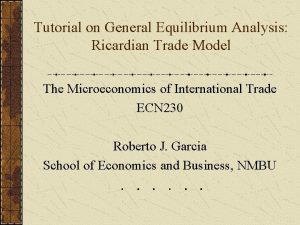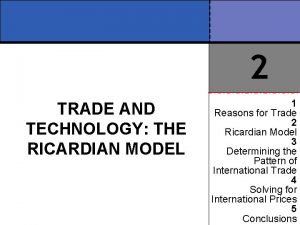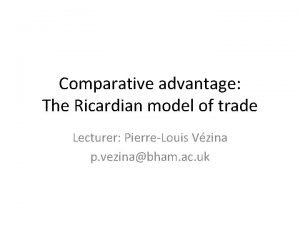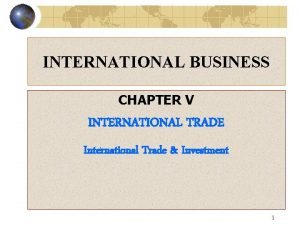The Ricardian Theory of Trade ECO 41 International
















































































- Slides: 80

The Ricardian Theory of Trade ECO 41 International Economics Udayan Roy http: //myweb. liu. edu/~uroy/eco 41/

The Ricardian Model • Please see Chapter 3 (Labor Productivity and Comparative Advantage: The Ricardian Model) in International Economics, ninth edition, by Krugman, Obstfeld, and Melitz.

The Ricardian Assumptions—Basics • There are – two countries, Home and Foreign – two goods, Cheese and Wine, and – one resource, Labor • Labor is used to produce cheese and wine

The Ricardian Assumptions—Preferences • The preferences of all consumers in the world are identical. • Q: This is obviously untrue. Why then does David Ricardo assume identical preferences? • A: Ricardo wants to show that technological differences between countries can lead to trade. To accomplish this goal he needs to show the existence of trade among two countries that differ only in technology.

Relative Price of Cheese: Example • The dollar price of wine, PW, is $5 per gallon • The dollar price of cheese, PC, is $20 per pound • Then the relative price of cheese is 4 gallons of wine per pound of cheese, and • Therefore, the relative price of cheese is the wine-equivalent of whatever one pays to buy cheese (PC/PW)

Relative Price of Wine: Example • The dollar price of wine, PW, is $5 per gallon • The dollar price of cheese, PC, is $20 per pound • Then the relative price of wine is ¼ pound of cheese per gallon of wine, and • Therefore, the relative price of wine is the cheese-equivalent of whatever one pays to buy wine (PW/PC)

Relative Prices • We just saw that the relative price of wine is PW/PC and the relative price of cheese is PC/PW • Therefore, the relative price of wine and the relative price of cheese are reciprocals – Their product must be the number one (1) • Therefore, if one relative price increases, the other necessarily decreases

The Relative Demand Curve • The relative demand curve shows the relative quantities bought by consumers at all possible values of the relative price PC/PW – See Figure 3 -3 in the textbook RD QC/QW As cheese becomes more expensive relative to wine (PC/PW↑) the consumption of cheese decreases relative to wine (QC/QW↓).

The Ricardian Assumptions—Technology • Goods are produced (out of labor) with technologies that satisfy Constant Returns to Scale. – That is, if the amount of labor employed in wine (respectively, cheese) production is doubled, then the amount of wine (respectively, cheese) produced will also double. – Put another way, the unit labor requirement in wine (respectively, cheese) production is constant

Technology—Our Example Unit Labor requirements Home Cheese Wine 1 hour per pound 2 hours per gallon a. C, H = 1 a. W, H = 2 Foreign 6 hours per pound 3 hours per gallon a. C, F = 6 a. W, F = 3 We will be using this specific example throughout this lecture

Opportunity Costs • The opportunity cost of a gallon of wine is the number of pounds of cheese you will no longer have the resources to produce if you produce a gallon of wine (CWC)

Example: Opportunity Cost Unit Labor requirements Opportunity Cost Cheese Wine Home 1 hour per pound 2 hours per gallon Cheese CCW Home Foreign 6 hours per pound 3 hours per gallon Foreign Wine CWC

Example: Opportunity Cost Unit Labor requirements Opportunity Cost Cheese Wine Home 1 hour per pound 2 hours per gallon Cheese CCW Home Foreign 6 hours per pound 3 hours per gallon Foreign ½ gallons of wine Wine CWC

Example: Opportunity Cost Unit Labor requirements Opportunity Cost (A commodity’s opportunity cost is computed as its unit labor requirement divided by the other commodity’s unit labor requirement. ) Cheese Wine Home 1 hour per pound 2 hours per gallon Cheese CCW Wine CWC Home ½ gallons of wine 2 pounds of cheese Foreign 6 hours per pound 3 hours per gallon Foreign

Example: Opportunity Cost Unit Labor requirements Opportunity Cost (A commodity’s opportunity cost is computed as its unit labor requirement divided by the other commodity’s unit labor requirement. ) Cheese Wine Home 1 hour per pound 2 hours per gallon Cheese CCW Wine CWC Home ½ gallons of wine 2 pounds of cheese Foreign 6 hours per pound 3 hours per gallon Foreign 2 gallons of wine

Example: Opportunity Cost Unit Labor requirements Opportunity Cost (A commodity’s opportunity cost is computed as its unit labor requirement divided by the other commodity’s unit labor requirement. ) Cheese Wine Home 1 hour per pound 2 hours per gallon Cheese CCW Wine CWC Home ½ gallons of wine 2 pounds of cheese Foreign 6 hours per pound 3 hours per gallon Foreign 2 gallons of wine ½ pounds of cheese

Rational Producers • If PC/PW > CCW, producers will be specialized in cheese production; no rational producer will make wine • Similarly, if PC/PW < CCW, producers will be specialized in wine production • Therefore, both wine and cheese will be produced only if PC/PW = CCW. – This is the autarky outcome

Example: Autarky Relative Prices Unit Labor requirements Opportunity Cost = Autarky Relative Price This completes the demonstration of the Ricardian idea that technology differences can lead to trade. Why? Cheese Wine Home 1 hour per pound 2 hours per gallon Foreign 6 hours per pound 3 hours per gallon Cheese CCW = PC/PW Wine CWC = PW/PC Home ½ gallons of wine 2 pounds of cheese Foreign 2 gallons of wine ½ pounds of cheese We have shown that the autarky relative price of cheese 2 in Foreign and ½ in Home. It follows that once trade is allowed, trade will occur. Home will export cheese and Foreign will export wine, in return.

Example: Specialization (PC/PW < ½) • Note that, if, under free trade, the global relative price of cheese is less than half, then PC/PW < CCW for both countries • Therefore, both countries must be specialized in wine • Therefore, the relative worldwide supply of cheese (QC/QW) must be zero Opportunity Cost Cheese CCW Wine CWC Home ½ gallons of wine 2 pounds of cheese Foreign 2 gallons of wine ½ pounds of cheese

Example: Specialization (PC/PW < ½) • If, under free trade, the global price of cheese is less than half (PC/PW < ½), then both countries must be specialized in wine (QC/QW = 0) PC/PW Foreign 2 Opportunity Cost 1 Cheese CCW Wine CWC Home ½ gallons of wine 2 pounds of cheese Home ½ Foreign 2 gallons of wine ½ pounds of cheese 0 QC/QW

Example: Specialization (2 > PC/PW > ½) • If, under free trade, the global relative price of cheese is between two and half, then PC/PW < CCW for Foreign and PC/PW > CCW for Home • Therefore, Foreign will specialize in wine and Home will specialize in cheese Opportunity Cost Cheese CCW Wine CWC Home ½ gallons of wine 2 pounds of cheese Foreign 2 gallons of wine ½ pounds of cheese

Example: Specialization (2 > PC/PW > ½) • Therefore, the quantity of cheese produced must be LH/a. CH, where LH is the amount of labor in Home, and … • … the quantity of wine produced must be LF/a. WF, where LF is the amount of labor in Foreign • The ratio of the outputs, QC/QW, can then be calculated – This is G in the diagram

Example: Specialization (2 > PC/PW > ½) • If 2 > PC/PW > ½, Foreign specializes in wine and Home specializes in cheese PC/PW Foreign 2 Opportunity Cost 1 Cheese CCW Wine CWC Home ½ gallons of wine 2 pounds of cheese Home ½ Foreign 2 gallons of wine ½ pounds of cheese 0 G QC/QW

Example: Specialization (PC/PW > 2) • Note that, if, under free trade, the global relative price of cheese is more than two, then PC/PW > CCW for both countries • Therefore, both countries must be specialized in cheese • Therefore, the relative worldwide supply of cheese (QC/QW) must be infinite Opportunity Cost Cheese CCW Wine CWC Home ½ gallons of wine 2 pounds of cheese Foreign 2 gallons of wine ½ pounds of cheese

Example: Specialization (PC/PW > 2) • If PC/PW > 2, both countries specialize in cheese PC/PW Foreign 2 Opportunity Cost 1 Cheese CCW Wine CWC Home ½ gallons of wine 2 pounds of cheese Home ½ Foreign 2 gallons of wine ½ pounds of cheese 0 G QC/QW

Example: Relative Supply Curve • This is the relative supply curve PC/PW RS Foreign 2 Opportunity Cost 1 Cheese CCW Wine CWC Home ½ gallons of wine 2 pounds of cheese Home ½ Foreign 2 gallons of wine ½ pounds of cheese 0 G QC/QW

The Ricardian Assumptions—Markets • There is perfect competition in all markets. – That is, no buyer or seller of a commodity has the power to affect the price of the commodity by himself. – More specifically, the market for a commodity is said to be perfectly competitive if: • There are many sellers • There are many buyers • All sellers sell the exact same product • Individuals make decisions so as to maximize happiness, whereas • Firms make decisions so as to maximize profits

The Ricardian Assumptions—Governments • Governments do not interfere with the smooth functioning of markets; there are no taxes, subsidies, tariffs, quotas, etc.

Example: Free Trade Equilibrium • The Ricardian theory assumes that the relative price of cheese will ensure the equality of relative demand relative supply – See Figure 3 -3 of the textbook PC/PW RS Foreign 2 1 RD Home ½ 0 G QC/QW

Free Trade Equilibrium PC/PW Higher of the two autarky relative prices of cheese = RS Higher of the two countries’ opportunity costs of cheese (CCW) Free Trade Price Lower of the two autarky relative prices of cheese = RD Lower of the two countries’ opportunity costs of cheese (CCW) 0 G QC/QW

Free Trade Equilibrium Note that trade raises the relative price of cheese in the country that has the lower relative price of cheese in autarky Higher of the two autarky relative prices of cheese = PC/PW RS Higher of the two countries’ opportunity costs of cheese (CCW) Free Trade Price Lower of the two autarky relative prices of cheese = RD Lower of the two countries’ opportunity costs of cheese (CCW) 0 G QC/QW

Free Trade Equilibrium Trade reduces the relative price of cheese in the country that has the higher relative price of cheese in autarky Higher of the two autarky relative prices of cheese = PC/PW RS Higher of the two countries’ opportunity costs of cheese (CCW) Free Trade Price Lower of the two autarky relative prices of cheese = RD Lower of the two countries’ opportunity costs of cheese (CCW) 0 G QC/QW

Free Trade → Specialization PC/PW Note that, as the free trade relative price of cheese is lower than the higher of the two opportunity costs of cheese, the country with the higher opportunity cost of cheese will make only wine and no cheese. Specialization follows comparative advantage RS Free Trade Price Similarly, as the free trade relative price of cheese is higher than the lower of the two opportunity costs of cheese, the country with the lower opportunity cost of cheese will make only cheese and no wine. RD 0 G QC/QW

Example: Free Trade Equilibrium • When autarky ends and free trade begins: – The relative price of cheese will rise in Home and fall in Foreign – Foreign will specialize in wine production and export wine to Home – Home will specialize in cheese production and export cheese to Foreign PC/PW RS Foreign 2 1 RD Home ½ 0 G QC/QW

Comparative Advantage • Each country exports the good that it had been producing at a cheaper relative price in autarky • Relative Price = Opportunity Cost • Therefore, each country exports the good for which its opportunity cost is lower • This is called the Principle of Comparative Advantage

GAINS FROM TRADE

Example: Gains from Trade Opportunity Cost • In autarky, Foreign can make 1 pound of cheese at a sacrifice of 2 gallons of wine • But under free trade, it can import 1 pound of cheese for 1 gallon of wine PC/PW Cheese CCW Wine CWC Home ½ gallons of wine 2 pounds of cheese Foreign 2 gallons of wine ½ pounds of cheese RS Foreign 2 1 RD Home ½ 0 G QC/QW

Example: Gains from Trade Opportunity Cost • In autarky, Home can make 1 gallon of wine at a sacrifice of 2 pounds of cheese • But under free trade, Home can import 1 gallon of wine for 1 pound of cheese PC/PW Cheese CCW Wine CWC Home ½ gallons of wine 2 pounds of cheese Foreign 2 gallons of wine ½ pounds of cheese RS Foreign 2 1 RD Home ½ 0 G QC/QW

Example: Gains from Trade PC/PW Opportunity Cost (Autarky) Cheese CCW Wine CWC Home ½ gallons of wine 2 pounds of cheese Foreign 2 gallons of wine ½ pounds of cheese RS Foreign 2 Opportunity Cost (Free Trade) Cheese CCW Wine CWC Home ½ gallons of wine 1 pound of cheese Foreign 1 gallon of wine ½ pounds of cheese 1 RD Home ½ Globalization is like making technological progress without having to do any of the hard work usually needed for technological progress! 0 G QC/QW

Wage Gains from Trade • The gains from trade can also be expressed in terms of the wages earned by labor.

No Profits in Ricardo’s World! • In Ricardo’s theory, workers have everything they need to produce things. – They know the technology that is needed to make things and they possess the ability to work. • Therefore, in Ricardo’s world, all revenues from the sale of produced goods go to workers • That is, the wage for an hour’s work equals the entire output of an hour’s work

Gains from trade • We can show labor’s gains from trade by examining how the relative wage that labor gets is affected by trade

Relative Wages • The relative wage is the purchasing power of the (nominal) dollar wage, w. • Therefore, to see whether labor gains from trade, we need to look at what trade does to the relative wage. • The relative wage may be measured in units of cheese (or wine) as the amount of cheese (or wine) that may be bought with the (nominal) dollar wage.

Relative Wage—Example • Suppose the (nominal) wage is 20 Yuan and the (nominal) price of cheese is 5 Yuan. • Then the relative wage (in units of cheese) is 4 pounds of cheese • Formula: In general, the relative wage in units of a given good is calculated by dividing the (nominal) wage by the (nominal) price of the given good. – Relative wage = w/P

Unit Labor Requirements and Productivity: How Related? • In our numerical example: – a. CF = 6 hours – That is, in Foreign, 6 hours of labor are needed to produce 1 pound of cheese – Therefore, 1 hour of labor produces 1/6 pounds of cheese • That is, the productivity of labor in Foreign is 1/6 pounds of cheese – Therefore, the relative wage (in cheese) of a worker in Foreign making cheese is 1/6 pounds of cheese

Relative Wages in Autarky • Note that the autarky relative wage in units of a commodity is the reciprocal of the unit labor requirement in the production of that commodity • Therefore, relative wage = productivity Autarky Relative Wages In units of Cheese In units of Wine Home 1/a. CH 1/a. WH Foreign 1/a. CF 1/a. WF

Autarky Real Wages and Productivity Unit Labor requirements Relative Wage (In units of each commodity) Cheese Wine Home 1 hour per pound 2 hours per gallon Home 1 pound of Cheese ½ gallon of Wine Foreign 6 hours per pound 3 hours per gallon Foreign 1/6 pound of Cheese 1/3 gallon of Wine Labor Productivity (In units of each commodity) Cheese Wine Home 1 pound of Cheese ½ gallon of Wine Foreign 1/6 pound of Cheese 1/3 gallon of Wine Note that the relative wage equals productivity. This idea is part of the Neo-Classical Theory of Income Distribution. What happens to relative wages when autarky ends and free trade begins?

Do Wages Reflect Productivity?

Do Wages Reflect Productivity? (cont. ) • Other evidence shows that wages rise as productivity rises. – In 2000, South Korea’s labor productivity was 35% of the US level and its average wages were about 38% of US average wages. – After the Korean War, South Korea was one of the poorest countries in the world, and its labor productivity was very low. In 1975, average wages in South Korea were still only 5% of US average wages.

Relative Wages—Free Trade • We saw earlier that if a good is produced, then relative wage equals productivity: w/P = 1/a • As Home produces Cheese both in autarky and free trade, the relative wage in units of cheese in Home will be the same in autarky and free trade • Similarly, as Foreign produces Wine both in autarky and free trade, the relative wage in units of Wine in Foreign will be the same in autarky and free trade

Relative Wages: Autarky and Trade Unit Labor requirements Free Trade Relative Wage Cheese Wine Home 1 hour per pound 2 hours per gallon Home 1 pound of Cheese ? Foreign 6 hours per pound 3 hours per gallon Foreign ? 1/3 gallon of Wine The relative wage in units of the exported good does not change!!! Labor Productivity Autarky Relative Wage Cheese Wine Home 1 pound of Cheese ½ gallon of Wine Foreign 1/6 pound of Cheese 1/3 gallon of Wine

Relative Wages: Autarky and Trade • The remaining mystery is about the relative wage in units of Wine in Home (w. H/PW, H) and the real wage in units of Cheese in Foreign (w. F/PC, F) • That is, for each country, the relative wage in units of the imported good is still unclear

Relative Wages—Free Trade 3. Therefore, increases when trade begins 1. Unaffected by trade 2. Increases when trade begins

Relative Wages—Free Trade 3. Therefore, increases when trade begins 1. Unaffected by trade 2. Increases when trade begins

Relative Wages—Autarky and Free Trade • The relative wage in units of the exported good does not change • The relative wage in units of the imported good increases, reflecting the gains from trade • Labor is better off. – And the gains come from the increases in purchasing power due to the availability of cheaper imports

Exceptions: Free Trade Equilibrium In this unusual case, Home is so large compared to Foreign that trade with Foreign makes no difference to relative prices in Home continues to produce both goods, even under free trade, whereas Foreign specializes in wine. The smaller country (Foreign ) gains a lot from trade, but the bigger country (Home) does not. PWC RS Home 2 RD Foreign ½ 0 G QW/QC

Exceptions: Free Trade Equilibrium PWC In this unusual case, Foreign is so large compared to Home that trade with Home makes no difference to relative prices in Foreign continues to produce both goods, even under free trade, whereas Home specializes in cheese. The smaller country (Home) gains a lot from trade, but the bigger country (Foreign) does not. Home 2 Foreign ½ 0 RS RD G QW/QC

Ricardian Model: Main Lessons • Trade occurs because technology varies from country to country • Even backward countries—such as Foreign in our numerical example—can gain from trade with advanced countries— such as Home • Advanced countries can gain from trade even if their workers have to compete with “cheap labor” countries

Misconceptions About Comparative Advantage 1. Free trade is beneficial only if a country is more productive than foreign countries. – But even an unproductive country benefits from free trade by avoiding the high costs for goods that it would otherwise have to produce domestically. – High costs derive from inefficient use of resources. – The benefits of free trade do not depend on absolute advantage, rather they depend on comparative advantage: specializing in industries that use resources most efficiently.

Misconceptions About Comparative Advantage (cont. ) 2. Free trade with countries that pay low wages hurts high wage countries. – While trade may reduce wages for some workers, thereby affecting the distribution of income within a country, trade benefits consumers and other workers. – Consumers benefit because they can purchase goods more cheaply (more wine in exchange for cheese). – Producers/workers benefit by earning a higher income (by using resources more efficiently and through higher prices/wages).

Misconceptions About Comparative Advantage (cont. ) 3. Free trade exploits less productive countries. – While labor standards in some countries are less than exemplary compared to Western standards, they are so with or without trade. – Are high wages and safe labor practices alternatives to trade? Deeper poverty and exploitation (e. g. , involuntary prostitution) may result without export production. – Consumers benefit from free trade by having access to cheaply (efficiently) produced goods. – Producers/workers benefit from having higher profits/wages—higher compared to the alternative.

Transportation Costs and Non-traded Goods • The Ricardian model predicts that countries should completely specialize in production. • But this rarely happens for primarily 3 reasons: 1. More than one factor of production reduces the tendency of specialization (chapter 4) 2. Protectionism (chapters 8– 11) 3. Transportation costs reduce or prevent trade, which may cause each country to produce the same good or service

Transportation Costs and Non-traded Goods (cont. ) • Non-traded goods and services (e. g. , haircuts and auto repairs) exist due to high transportation costs. – Countries tend to spend a large fraction of national income on non-traded goods and services. – This fact has implications for the gravity model and for models that consider how income transfers across countries affect trade.

Empirical Evidence • Do countries export those goods in which their productivity is relatively high? • The ratio of US to British exports in 1951 compared to the ratio of US to British labor productivity in 26 manufacturing industries suggests yes. • At this time the US had an absolute advantage in all 26 industries, yet the ratio of exports was low in the least productive sectors of the US.

Empirical Evidence (cont. )

Exercise: Autarky Relative Prices Unit Labor requirements Relative Price (In units of the other good) Cheese Wine Home 4 hour per pound 1 hours per gallon Home Foreign 2 hours per pound 6 hours per gallon Foreign Cheese Wine

Exercise: Autarky Relative Prices Unit Labor requirements Relative Price (In units of the other good) Cheese Wine Home 4 hour per pound 1 hours per gallon Home Foreign 2 hours per pound 6 hours per gallon Foreign Cheese 4 gallons of Wine

Exercise: Autarky Relative Prices Unit Labor requirements Relative Price (In units of the other good) Cheese Wine Home 4 hour per pound 1 hours per gallon Home Foreign 2 hours per pound 6 hours per gallon Foreign Cheese Wine 4 gallons of Wine ¼ pounds of Cheese

Exercise: Autarky Relative Prices Unit Labor requirements Relative Price (In units of the other good) Cheese Wine Home 4 hour per pound 1 hours per gallon Foreign 2 hours per pound 6 hours per gallon Cheese Wine Home 4 gallons of Wine ¼ pounds of Cheese Foreign 1/3 gallons of Wine

Exercise: Autarky Relative Prices Unit Labor requirements Relative Price (In units of the other good) Cheese Wine Home 4 hour per pound 1 hours per gallon Foreign 2 hours per pound 6 hours per gallon Q: Which country will export Cheese? Cheese Wine Home 4 gallons of Wine ¼ pounds of Cheese Foreign 1/3 gallons of Wine 3 pounds of Cheese A: Foreign

Exercise: Autarky Relative Prices Unit Labor requirements Relative Price (In units of the other good) Cheese Wine Home 4 hour per pound 1 hours per gallon Foreign 2 hours per pound 6 hours per gallon Q: Which country will export Cheese? Assume that in free trade 1 pound of cheese trades for 2 gallons of wine, and, equivalently, 1 gallon of wine trades for ½ pounds of cheese Cheese Wine Home 4 gallons of Wine ¼ pounds of Cheese Foreign 1/3 gallons of Wine 3 pounds of Cheese A: Foreign

Exercise: Autarky Relative Wages Unit Labor requirements Relative Wages (In units of the other good) Cheese Wine Home 4 hour per pound 1 hours per gallon Home Foreign 2 hours per pound 6 hours per gallon Foreign Cheese Wine

Exercise: Autarky Relative Wages Unit Labor requirements Relative Wages (In units of the other good) Cheese Wine Home 4 hour per pound 1 hours per gallon Home Foreign 2 hours per pound 6 hours per gallon Foreign Cheese ¼ pounds of cheese Wine

Exercise: Autarky Relative Wages Unit Labor requirements Relative Wages (In units of the other good) Cheese Wine Home 4 hour per pound 1 hours per gallon Home ¼ pounds of cheese Foreign 2 hours per pound 6 hours per gallon Foreign ½ pounds of cheese Cheese Wine

Exercise: Autarky Relative Wages Unit Labor requirements Relative Wages (In units of the other good) Cheese Wine Home 4 hour per pound 1 hours per gallon Foreign 2 hours per pound 6 hours per gallon Cheese Wine Home ¼ pounds of cheese 1 gallon of wine Foreign ½ pounds of cheese 1/6 gallons of wine

Exercise: Free Trade Relative Wages Unit Labor requirements Home Foreign Relative Wages (In units of the other good) Cheese Wine 4 hour per pound 1 hours per gallon Home 2 hours per pound 6 hours per gallon Foreign Assume that in free trade 1 pound of cheese trades for 2 gallons of wine, and, equivalently, 1 gallon of wine trades for ½ pounds of cheese Cheese Wine

Exercise: Free Trade Relative Wages Unit Labor requirements Home Foreign Relative Wages (In units of the other good) Cheese Wine 4 hour per pound 1 hours per gallon Home 2 hours per pound 6 hours per gallon Foreign Assume that in free trade 1 pound of cheese trades for 2 gallons of wine, and, equivalently, 1 gallon of wine trades for ½ pounds of cheese Cheese Wine 1 gallon of wine ½ pounds of cheese

Exercise: Free Trade Relative Wages Unit Labor requirements Home Foreign Relative Wages (In units of the other good) Cheese Wine 4 hour per pound 1 hours per gallon 2 hours per pound 6 hours per gallon Assume that in free trade 1 pound of cheese trades for 2 gallons of wine, and, equivalently, 1 gallon of wine trades for ½ pounds of cheese Cheese Wine Home ½ pounds of cheese 1 gallon of wine Foreign ½ pounds of cheese 1 gallons of wine

Exercise: What does Free Trade do to Relative Wages Unit Labor requirements Home Foreign Free Trade Relative Wages (In units of the other good) Cheese Wine 4 hour per pound 1 hours per gallon 2 hours per pound 6 hours per gallon Cheese Wine Home ½ pounds of cheese 1 gallon of wine Foreign ½ pounds of cheese 1 gallon of wine Autarky Relative Wages (In units of the other good) Assume that in free trade 1 pound of cheese trades for 2 gallons of wine, and, equivalently, 1 gallon of wine trades for ½ pounds of cheese Cheese Wine Home ¼ pounds of cheese 1 gallon of wine Foreign ½ pounds of cheese 1/6 gallons of wine

We’re Done! • Any questions or comments?
 Scarcity rent definition
Scarcity rent definition Gradient
Gradient Ricardian equivalence
Ricardian equivalence Ricardian model relative price
Ricardian model relative price Ricardian model ppf
Ricardian model ppf Ipe is
Ipe is Mercantilism
Mercantilism Materi current theory of international trade
Materi current theory of international trade International trade theory
International trade theory International trade theory
International trade theory International trade theory
International trade theory Global strategic rivalry theory of international trade
Global strategic rivalry theory of international trade Kravis theory
Kravis theory Product life cycle theory of international trade
Product life cycle theory of international trade Trade diversion and trade creation
Trade diversion and trade creation Umich
Umich Which is the most enduring free trade area in the world?
Which is the most enduring free trade area in the world? The trade in the trade-to-gdp ratio
The trade in the trade-to-gdp ratio Fair trade not free trade
Fair trade not free trade Trade diversion and trade creation
Trade diversion and trade creation Tramp trade software
Tramp trade software What is triangle trade
What is triangle trade Unit 8
Unit 8 International trade and foreign exchange
International trade and foreign exchange Chapter 6 - theories of international trade and investment
Chapter 6 - theories of international trade and investment Importance of international trade
Importance of international trade The dynamic environment of international trade summary
The dynamic environment of international trade summary Certificate in international trade and finance citf
Certificate in international trade and finance citf Embargo definition
Embargo definition Chapter 4 global analysis
Chapter 4 global analysis Djibouti international free trade zone
Djibouti international free trade zone Nature of trade
Nature of trade Disadvantages of international trade
Disadvantages of international trade Credit risk in international trade
Credit risk in international trade Supplier blue genipa
Supplier blue genipa Advantages of international trade
Advantages of international trade Trade vocabulary
Trade vocabulary Vocabulary unit 7
Vocabulary unit 7 International trade data system
International trade data system Recent trends in indian foreign trade
Recent trends in indian foreign trade Exim international trade consultants
Exim international trade consultants International trade and finance topics
International trade and finance topics International rules for the interpretation of trade terms
International rules for the interpretation of trade terms Theories of international trade and investment
Theories of international trade and investment International trade
International trade International trade food
International trade food International trade
International trade International trade contract
International trade contract What is international trade
What is international trade International rules for the interpretation of trade terms
International rules for the interpretation of trade terms International trade
International trade Dynamic environment of international trade
Dynamic environment of international trade International trade key terms
International trade key terms Essential industry argument
Essential industry argument Chapter 9 application: international trade answers
Chapter 9 application: international trade answers Hát kết hợp bộ gõ cơ thể
Hát kết hợp bộ gõ cơ thể Slidetodoc
Slidetodoc Bổ thể
Bổ thể Tỉ lệ cơ thể trẻ em
Tỉ lệ cơ thể trẻ em Voi kéo gỗ như thế nào
Voi kéo gỗ như thế nào Tư thế worm breton là gì
Tư thế worm breton là gì Bài hát chúa yêu trần thế alleluia
Bài hát chúa yêu trần thế alleluia Môn thể thao bắt đầu bằng từ chạy
Môn thể thao bắt đầu bằng từ chạy Thế nào là hệ số cao nhất
Thế nào là hệ số cao nhất Các châu lục và đại dương trên thế giới
Các châu lục và đại dương trên thế giới Cong thức tính động năng
Cong thức tính động năng Trời xanh đây là của chúng ta thể thơ
Trời xanh đây là của chúng ta thể thơ Mật thư anh em như thể tay chân
Mật thư anh em như thể tay chân Phép trừ bù
Phép trừ bù độ dài liên kết
độ dài liên kết Các châu lục và đại dương trên thế giới
Các châu lục và đại dương trên thế giới Thể thơ truyền thống
Thể thơ truyền thống Quá trình desamine hóa có thể tạo ra
Quá trình desamine hóa có thể tạo ra Một số thể thơ truyền thống
Một số thể thơ truyền thống Bàn tay mà dây bẩn
Bàn tay mà dây bẩn Vẽ hình chiếu vuông góc của vật thể sau
Vẽ hình chiếu vuông góc của vật thể sau Biện pháp chống mỏi cơ
Biện pháp chống mỏi cơ đặc điểm cơ thể của người tối cổ
đặc điểm cơ thể của người tối cổ Ví dụ giọng cùng tên
Ví dụ giọng cùng tên Vẽ hình chiếu đứng bằng cạnh của vật thể
Vẽ hình chiếu đứng bằng cạnh của vật thể Vẽ hình chiếu vuông góc của vật thể sau
Vẽ hình chiếu vuông góc của vật thể sau

